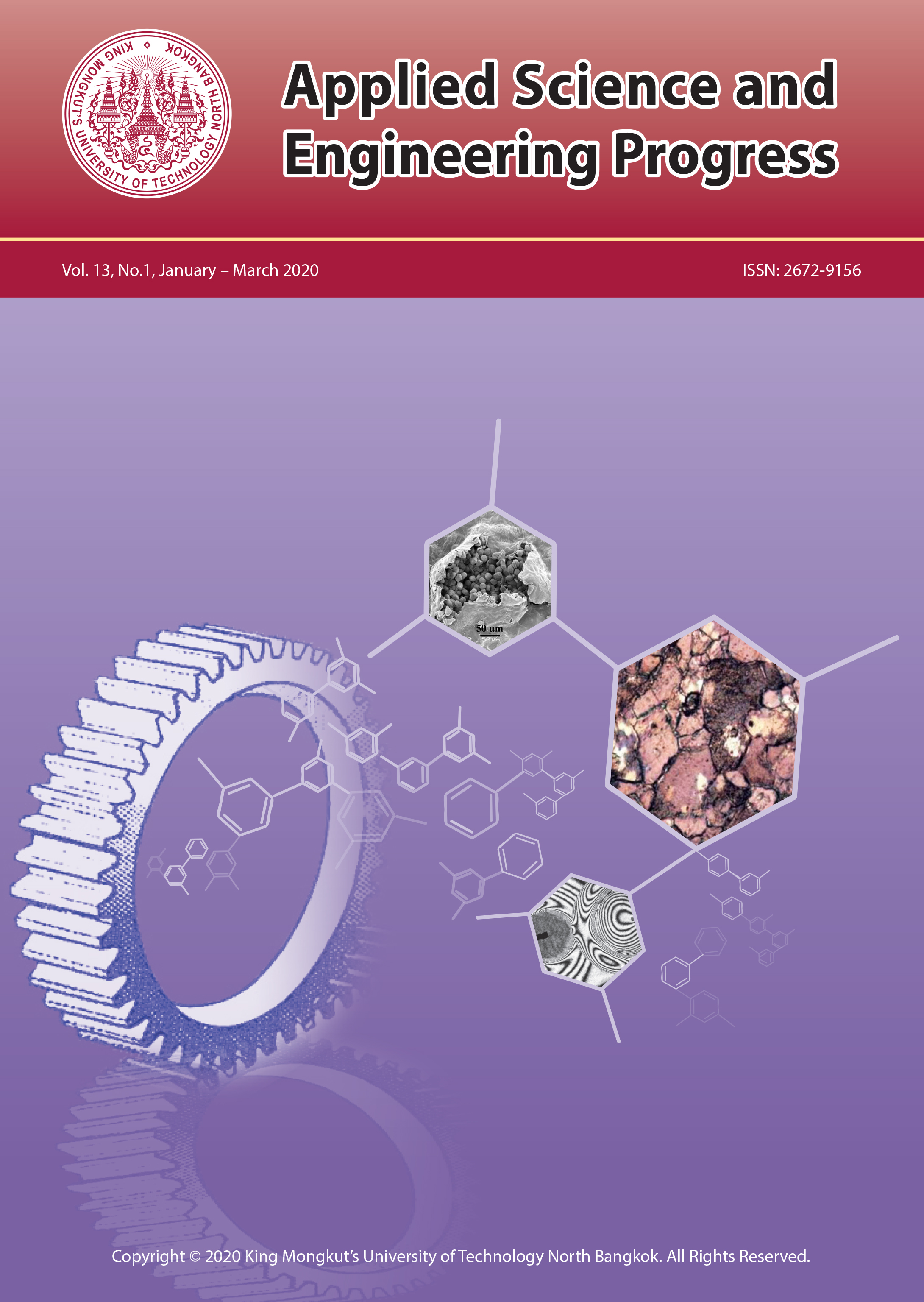Effect of Oscillating Magnetic Field on Freezing Rate, Phase Transition Time and Supercooling of Deionized Water
Main Article Content
Abstract
Due to a growing interest toward quality improvement of frozen foods, many advanced technologies have been combined with conventional freezing system to expedite rate of freezing and reduce ice crystal formation. This research aimed to investigate the effect of oscillating magnetic field (OMF) in the range of 0 to 12 mT (50 Hz) on freezing rate, phase transition time and supercooling of deionized water during freezing in an air blast freezer at –10°C. The sample was placed between two magnetic cores where an oscillating magnetic field (OMF) was generated and the temperature profile was recorded by a data logger at 1-minute interval. The magnetic field strength was varied at 0, 4, 8, and 12 mT. It was found that there was no significant difference in the freezing rate and phase transition time when different OMF strengths were applied (p > 0.05). Interestingly, the probability of supercooling occurrence increased when the OMF was applied; without OMF only 16% of the experiment exhibited supercooling phenomenon where 33% was detected when OMF in the range of 4–12 mT was applied. However, the probability of supercooling occurrence was independent of the OMF strength.
Article Details
References
[2] S. J. James and C. James, “Innovative freezing technologies for foods,” New Food, vol. 15, pp. 21–24, Sep. 2012.
[3] V. D. Aleksandrov, A. A. Barannikov, and N. V. Dobritsa, “Effect of magnetic field on the supercooling of water drops,” Inorganic Materials, vol. 36, pp. 895–898, Sep. 2000.
[4] Y. J. Lou, H. X. Zhao, W. B. Li, and J. T. Han, “Experimental of the effects of static magnetic field on carp frozen process,” Journal of Shandong University, vol. 43, pp. 89–95, Jun. 2013.
[5] C. James, B. Reitz, and S. J. James, “The freezing characteristics of garlic bulbs (Allium sativum L.) frozen conventionally or with the assistance of an oscillating weak magnetic field,” Food and Bioprocess Technology, vol. 8, pp. 705–708, Mar. 2015.
[6] J. H. Mok, W. Choi, S. H. Park, S. H. Lee, and S. J. Jun, “Emerging pulsed electric field (PEF) and static magnetic field (SMF) combination technology for food freezing,” International Journal of Refrigeration, vol. 50, pp. 137–145, Feb. 2015.
[7] L. Otero, M. Pérez-Mateos, A. C. Rodríguez, and P. D. Sanz, “Electromagnetic freezing: Effects of weak oscillating magnetic fields on crab sticks,” Journal of Food Engineering, vol. 200, pp. 87–94, May. 2017.
[8] A. C. Rodríguez, C. James, and S. J. James, “Effects of weak oscillating magnetic fields on the freezing of pork loin,” Food and Bioprocess Technology, vol. 10, pp. 1615–1621, Sep. 2017.
[9] H. X. Zhao, H. Q. Hu, S. Liu, and J. T. Han, “Experimental study on freezing of liquids under static magnetic field,” Chinese Journal of Chemical Engineering, vol. 25, pp. 1288–1293, Sep. 2017.
[10] M. W. Woo and A. S. Mujumdar, “Effects of electric and magnetic field on freezing and possible relevance in freeze drying,” Drying Technology, vol. 28, pp. 433–443, Apr. 2010.
[11] H. Ino, Y. Suzuki, T. Katamura, S. Tsuji, and Y. Kurihara, “Food freezer and food thawing apparatus,” JP Patent 2005–291525, 2005.
[12] N. Owada, “Highly-efficient freezing apparatus and high-efficient freezing method,” U.S. Patent US 7, 237, 400B2, 2007.
[13] N. Owada and S. Saito, “Quick freezing apparatus and quick freezing method,” U.S. Patent US 7, 810, 340 B2, 2010.
[14] L. Otero, A. C. Rodríguez, M. Pérez-Mateos, and P. D. Sanz, “Effects of magnetic fields on freezing: Application to biological products, Comprehensive Reviews in Food Science and Food Safety, vol. 15, pp. 646–667, May 2016.
[15] E. Xanthakis, A. Le-Bail, and M. Havet, “Freezing combined with electrical and magnetic disturbances,” in Proceedings Emerging Technologies for Food Processing (Second Edition), 2014, pp. 566–567.
[16] J. H. Mok, J. Y. Her, T. Y. Kang, R. Hoptowit, and S. J. Jun, “Effects of pulsed electric field (PEF) and oscillating magnetic field (OMF) combination technology on the extension of supercooling for chicken breasts,” Journal of Food Engineering, vol. 196, pp. 27–35, Mar. 2017.
[17] W. Pawluk. (2019, Apr.). Static Magnetic Field VS. Pulsed Magnetic Field. Maryland, US [Online]. Available: https://www.drpawluk.com/ education/magnetic-science/static-vs-pulsedmagnetic- fields
[18] K. X. Zhou, G. W. Lu, Q. C. Zhou, and J. H. Song, “Monte Carlo simulation of liquid water in magnetic field,” Journal of Applied Physics, vol. 88, pp. 1802–1805, Jul. 2000.
[19] D. Jiles, Introduction to Magnetic and Magnetic Materials. London, England: Chapman and Hall, 1991, pp. 27–33.


